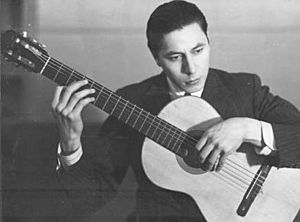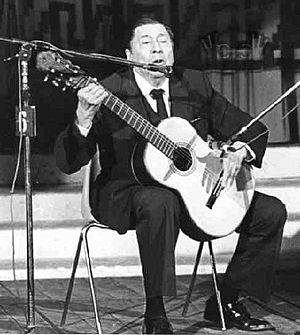Atahualpa Yupanqui facts for kids
Quick facts for kids
Atahualpa Yupanqui
|
|
|---|---|

Yupanqui in 1935
|
|
| Background information | |
| Birth name | Héctor Roberto Chavero Aramburu |
| Born | 31 January 1908 |
| Origin | Juan A. de la Peña, Pergamino Partido, Buenos Aires Province, Argentina |
| Died | 23 May 1992 (aged 84) Nîmes, France |
| Genres | Payada, trova |
| Occupation(s) | Singer, songwriter, writer |
| Instruments | Guitar, vocals |
Atahualpa Yupanqui (born Héctor Roberto Chavero Aramburu; January 31, 1908 – May 23, 1992) was a famous Argentine singer, songwriter, guitarist, and writer. Many people think he was the most important Argentine folk musician of the 20th century. His music and words told stories about the land and its people.
Contents
The Story of Atahualpa Yupanqui
Yupanqui was born Héctor Roberto Chavero Aramburu in Pergamino, Buenos Aires Province, Argentina. This was in the wide, flat lands known as the pampas. His father had roots from the Quechua people and Basque people. His mother was born in the Basque country. When he was nine, his family moved to Tucumán in Northwest Argentina.
He later chose the stage name Atahualpa Yupanqui. This name honored two legendary Incan kings. It became famous all over the world. In his younger years, Yupanqui traveled a lot. He explored the northwest of Argentina and the Altiplano region. He wanted to learn about the local cultures and traditions.
Yupanqui became involved in politics. He joined the Communist Party of Argentina. In 1931, he took part in a small uprising. This was against the government at the time. After the uprising failed, he had to go to Uruguay for safety. He came back to Argentina in 1934.
In 1935, Yupanqui visited Buenos Aires for the first time. His songs were becoming very popular. He was invited to perform on the radio. Soon after, he met Antonieta Paula Pepin Fitzpatrick. She was a pianist known as "Nenette." She became his partner for life and helped him with his music. She used the name "Pablo Del Cerro" for their musical work.
Because of his political connections, his music faced problems. During Juan Perón's time as president, his work was sometimes stopped. He was even held and put in jail a few times. Between 1944 and 1949, he lived in Uruguay. He performed there often. In 1949, he went to Europe.
Édith Piaf, a famous French singer, invited him to perform in Paris. This was on July 7, 1950. He quickly signed a deal with a record company called Le Chant du Monde. They released his first album in Europe, called Minero Soy (I am a Miner). This album won a big award for Best Foreign Disc. He then traveled and performed all over Europe.
In 1952, Yupanqui returned to Buenos Aires. He left the Communist Party. This made it easier for him to perform on the radio again. He and Nenette built their home in Cerro Colorado, Córdoba.
People started to widely recognize Yupanqui's work in the 1960s. He studied and shared knowledge about different cultures. New folk artists like Mercedes Sosa sang his songs. They made him very popular among younger musicians. They often called him Don Ata, which means "Mr. Ata."
Yupanqui lived in both Buenos Aires and Cerro Colorado. From 1963 to 1964, he toured many countries. These included Colombia, Japan, Morocco, Egypt, Israel, and Italy. In 1967, he toured Spain and then settled in Paris. He came back to Argentina regularly. He even appeared in a film called Argentinísima II in 1973. However, his visits became less frequent after 1976. This was when a military government took power in Argentina.
In February 1968, France honored Yupanqui. He was named a Knight of the Ordre des Arts et des Lettres. This award recognized his 18 years of work. His songs are even taught in schools that study Spanish literature.
In 1985, the Konex Foundation in Argentina gave him the Diamond Konex Award. This is one of the highest awards in Argentina. It recognized him as the most important Popular Musician of the past decade.
In 1989, a French university asked Yupanqui to write a special song. This was to celebrate 200 years since the French Revolution. The song was called "The Sacred Word." It was a tribute to all people who fought for their freedom.
Yupanqui passed away in Nîmes, France, in 1992. He was 84 years old. His ashes were spread on his beloved Colorado Hill on June 8, 1992.
Famous Songs
Here are some of Atahualpa Yupanqui's most well-known songs:
- "Basta Ya"
- "Los Hermanos"
- "Viene clareando"
- "El arriero"
- "Zamba del grillo"
- "La añera"
- "La pobrecita"
- "Milonga del peón de campo"
- "Camino del indio"
- "Chacarera de las piedras"
- "Recuerdos del Portezuelo"
- "El alazán"
- "Indiecito dormido"
- "El aromo"
- "Le tengo rabia al silencio"
- "Piedra y camino"
- "Luna tucumana"
- "Los Ejes De Mi Carreta"
- "Sin caballo y en Montiel"
- "Cachilo dormido"
- "Tú que puedes vuélvete"
- "Nada mas"
- "Preguntitas sobre Dios"
His Books
Yupanqui was also a writer. Here are some of his books:
- Piedra sola (1940)
- Aires indios (1943)
- Cerro Bayo (1953)
- Guitarra (1960)
- El canto del viento (1965)
- El payador perseguido (1972)
- La Capataza (1992)
His Music Albums
Here are some of Atahualpa Yupanqui's albums:
- Hits Collection Yupanqui Atahualpa
- Basta Ya 2006
- ¡Soy Libre! ¡Soy Bueno! (1968)
Honoring a Legend
On January 31, 2012, Google honored Atahualpa Yupanqui. They made a special Google Doodle for his 104th Birthday. This showed how important he was around the world.
See also
 In Spanish: Atahualpa Yupanqui para niños
In Spanish: Atahualpa Yupanqui para niños


